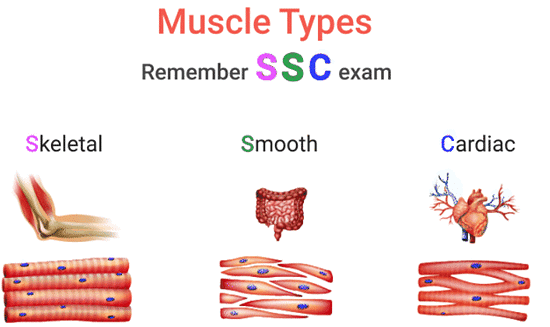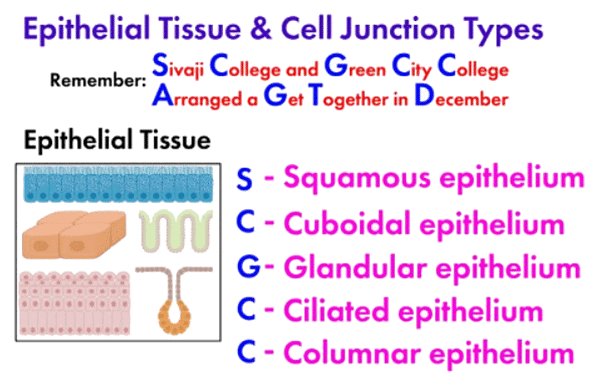Mnemonics: Structural Organisation in Animals | Biology Class 11 - NEET PDF Download
This document will help you remember important information about Structural Organisation in Animals in a fun and easy way. Inside, you'll find mnemonics—memory tricks—that will make it easier for you to remember key concepts, examples related to Structural Organisation in Animals.
Whether you're studying for an exam, preparing for a quiz, or simply looking to enhance your understanding of Structural Organisation in Animals, these mnemonics will serve as valuable memory tools. Utilize them alongside your regular study routine to reinforce your knowledge and increase your recall ability.
Happy mnemonic learning!
Memories Animal Tissue

Connective Tissue

Muscle Type
Mnemonic: SSC
Just remember "SSC exam" which can be used as a mnemonic to remember types of muscle.
Mnemonics Explanation: Mnemonic "SSC exam," you can easily recall the three types of muscles: Skeletal, Smooth, and Cardiac. This can be helpful for studying anatomy or simply remembering the different types of muscle in the human body.
Epithelial Tissue
Mnemonic: Sivaji College and Green City College Arranged a Get Together
"Sivaji College and Green City College Arranged a Get Together" remember this mnemonic for remembering the epithelial tissue and cell junction types.

Mnemonics Explanation: Mnemonic "Sivaji College and Green City College Arranged a Get Together," you can easily recall the different types of epithelial tissues (squamous, cuboidal, columnar, glandular) and the types of cell junctions (tight junctions, gap junctions, adherens junctions, desmosomes) found in epithelial tissue. This can be helpful for studying histology or simply remembering the different aspects of epithelial tissue and cell junctions.
Types of Connective Tissue
Mnemonic: DSLr
Here is a fun mnemonic "DSLr" which will help you to recall the types of connective tissue.
Mnemonics Explanation: Mnemonic "DSLr," you can easily recall the types of connective tissue: Dense, Specialized, Loose, and Reticular. This can be helpful for studying anatomy or simply remembering the different types of connective tissue in the body.
Examples of Connective Tissue
Mnemonic: Aditi Argued with Carl and BoB
"Aditi Argued with Carl and BoB" is the mnemonic that will help to remember examples of connective tissue.
Mnemonics Explanation: Mnemonic "Aditi Argued with Carl and BoB," you can easily recall some examples of connective tissue: Adipose, Areolar, Cartilage, and Bone. This can be helpful for studying anatomy or simply remembering different examples of connective tissue in the body.
Examples of Simple Columnar Epithelium
Mnemonic: Lal Bahadur Shastri was a Great Indian with simple living
"Lal Bahadur Shastri was a Great Indian with simple living" But why am I telling you this here? Actually, there is another mnemonic for you to help you in memorizing the examples of simple columnar epithelium.
Mnemonics Explanation: Mnemonic "Lal Bahadur Shastri was a Great Indian with simple living," you can remember some examples of simple columnar epithelium found in the small intestine, stomach, gallbladder, large intestine, and uterus. This can be helpful for studying histology or simply recalling the different locations where simple columnar epithelium is present in the body.
Excretory Organs Of Different Animals
Mnemonic: CoMal Eats Noodles
"CoMal Eats Noodles", must be wondering the spelling of Comal as it does not start with 'C' but 'K'. But this trick will help you to remember the excretory organ of cockroach and earthworm.
Mnemonics Explanation: Mnemonic "CoMal Eats Noodles," you can easily recall the excretory organs of the cockroach (Malpighian tubules) and earthworm (nephridia). This can be helpful for studying biology or simply remembering the excretory systems of these particular animals.
Cockroach - Mouth Parts
Mnemonic: Mansa learned HtML
The tiny cockroach has a little head. That little head has a small mouth with several parts. How not miss a single in the exam? Remember "Mansa learned HtML". Have a look at the image given below to know how to use this sentence for remembering the parts of the mouth of the cockroach.
Mnemonics Explanation: Mnemonic "Mansa learned HtML," you can remember the different parts of the cockroach's mouth: Mandibles, Labrum, Hypopharynx, maxillae, and Labium. This can be helpful for studying insect anatomy or simply remembering the components of a cockroach's mouth.
|
150 videos|399 docs|136 tests
|
FAQs on Mnemonics: Structural Organisation in Animals - Biology Class 11 - NEET
| 1. What are the main types of animal tissues? |  |
| 2. What are the different types of connective tissue and their examples? |  |
| 3. Can you provide examples of simple columnar epithelium and their functions? |  |
| 4. What are the excretory organs in different animals? |  |
| 5. How are the mouthparts of a cockroach adapted for its feeding habits? |  |






















